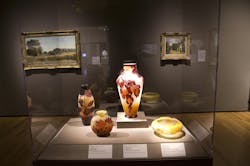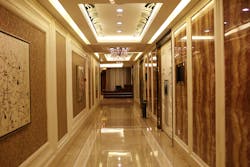Navigating evolving building energy codes and standards is a task that electrical contractors, engineers, designers, and building professionals face daily. Understanding the difference between the International Energy Conservation Code (IECC) and the standards set by the American Society of Heating, Refrigerating, and Air-Conditioning Engineers (ASHRAE) and the Illuminating Engineering Society (IES) is critical to ensuring code compliance and optimizing lighting efficiency in various building spaces.
Differentiating between codes and standards
It’s important to recognize the fundamental difference between codes and standards. The IECC, developed by the International Code Council (ICC), establishes minimum requirements for energy efficiency in buildings. It develops codes, which serve as a regulatory framework adopted by states and municipalities to enforce energy conservation measures in construction and renovation projects.
ASHRAE (and partner organizations) establish technical standards and guidelines for the design, construction, and operation of building systems. ASHRAE publishes various standards and guidelines, including ASHRAE 90.1, which specifies energy efficiency requirements that are referenced in codes and rating systems.
Varied landscapes of building code requirements
The challenge is understanding which lighting and control codes/standards apply to your designs and spaces. Some states and municipalities adhere to the IECC; others adopt ASHRAE 90.1. These codes and standards are typically updated every three years — with inconsistent adoption across states and municipalities. Recognizing the differences between the current codes and standards (and their recent updates) is critical for meeting regulatory requirements and delivering high-performing buildings.
Understanding IECC-2021
The 2021 IECC specifies changes aimed at reducing lighting energy consumption in commercial and residential buildings. The most significant change is a reduction in lighting power allowance (Sec. C405.3.2) for most building types. For example, the hospital lumen power density (LPD) dropped minimally from 1.05W/ft2 to 0.96W/ft2, while museums dropped significantly from 1.06W/ft2 to 0.55W/ft2, as shown in Photo 1.
Another change in IECC-2021 is a reduction in lighting power of at least 10% compared to the lighting power allowance (Sec. C406.3.1). This change requires the total interior lighting power load calculated with the equation method (Sec. C405.3.1) to be less than 90% of the total lighting power allowance in Sec. C405.3.2 (Building Area Method or Space-By-Space Method).
Lighting efficacy was increased in IECC-2021 and harmonized between the commercial (C406.3.3) and residential sections (R202). As a result of advancing LED technology, lamps must now have an efficacy of at least 65 lumens per watt, and luminaires must have an efficacy of at least 45 lumens per watt. Efficacy is no longer tiered based on wattage consumption.
How to address lighting power reduction
There are three methods to address lighting power requirements in the IECC. The first entails utilizing the Equation Method, which is calculation-based. The other two ways are the Building Area Method and the Space-By-Space Method. These popular methods are chart-based and deliver quicker results than the Equation Method. The allowances for the same space may differ between the two methods though, with the Space-By-Space Method typically resulting in a greater allowance.
For instance, a 20,000-square-foot library, comprised of 5,000 square feet of a reading area and 15,000 square feet of a stack area will have an allowance of 16,600W using the Building Area Method because of the 0.83 allowance. The Space-By-Space Method, however, results in a greater allowance of 22,500W because the reading area and the stack area are calculated separately using allowances of 0.96 and 1.18, respectively. When designing lighting, it is important to consider each unique space as well as the required light levels to ensure the occupants are safe and productive. Select luminaires that address the light levels to individual space needs while ensuring the overall power allowance complies with building code requirements.
Additions to IECC-2021
In the 2021 IECC, areas where occupancy sensors are required have been expanded to include corridors (Photo 2). This is to reduce the lighting power to no more than 50% of full power within 20 minutes of being unoccupied. Light reduction controls require manual control, allowing the occupant to reduce the light by no less than 50% using dimming, step dimming, or switching. Daylight-responsive controls now include secondary side-lit zones with more than 300W of general lighting within the zones. Daylight controls also cannot exceed an occupancy sensor’s pre-programmed unoccupied light level in the same spaces.
IECC-2021 includes a section for specific applications and requirements for task lighting for medical and dental applications. A manual control must be provided that is separate from the general lighting, and all lighting and switch receptacles must turn off within 20 minutes of occupants leaving the space.
The 2021 IECC also notes that 50% of all receptacles are to be controlled automatically in a variety of spaces, including private offices, conference rooms, individual workstations, and classrooms. Either split-controlled (top-controlled) or controlled receptacles must be marked per NFPA 70, National Electrical Code (NEC), located within 12 in. of each uncontrolled receptacle — and controlled by a schedule, occupancy sensor, or signal from another control or alarm system.
Exterior lighting control is typically controlled using a time switch. A new addition requires occupancy sensors to automatically reduce the lighting serving outdoor parking areas by 50% when no activity has been detected for 15 minutes. New parking garage requirements mandate a 30% reduction in lighting power when no activity has been detected for 20 minutes. Additionally lighting for covered vehicle entrances must decrease by 50% from sunset to sunrise to accommodate drivers’ vision adjustments. Daylight controls are also specified for parking garage luminaires within 20 feet of any perimeter wall structure.
Energy monitoring now required in IECC-2021
Energy monitoring requirements have been in the ASHRAE 90.1 Standard since 2013. The 2021 IECC now requires similar energy monitoring requirements for new buildings 25,000 square feet and larger for interior lighting, exterior lighting, plug loads, HVAC systems, process loads, building operations, and other miscellaneous loads. Energy usage must be automatically communicated to a data acquisition system with data stored for a minimum of 36 months and graphical data provided for each end-use category for every hour, day, month, and year for the previous 36 months.
Understanding ASHRAE 90.1
ASHRAE’s Standard 90.1, Energy Standard for Sites and Buildings Except Low-Rise Residential Buildings, provides the minimum requirements for energy-efficient building design and construction in most spaces. The 2022 edition of Standard 90.1 details lighting power allowances by zones and spaces. Notably, Sec. 9.3.2 outlines a simplified building method for calculating lighting power allowances. The allowances in this section are lower than the Building Area Method and Space-By-Space Method. This section applies only to office, education, and retail building types, which are under 25,000 square feet. In addition, most of the interior lighting power density allowances were reduced (Secs. 9.5.1 and 9.5.2), but they do not match the IECC reductions.
Additions to ASHRAE 90.1
ASHRAE 90.1-2022 introduces two new sections. The first focuses on horticultural lighting requirements. Given the advances in LED technology and interest in indoor growing, Sec. 9.4.4 requires greenhouse buildings with at least 40kW of connected load to have a photosynthetic photon efficiency (PPE) of 1.7 µmol/J (micromoles per joule) or greater. This section also requires automatic lighting controls for horticultural purposes. The second new area in 90.1-2022 addresses the rise in video conferencing (Sec. 9.5.2.2) by allowing an additional 0.50 W/ft² for increased clarity during video conferences.
Achieving code compliance
Keeping up and complying with the latest codes and standards can take time to learn and additional resources to evolve existing technologies and designs. However, they also present the opportunity for new, innovative lighting and control solutions that meet the need for energy-efficient spaces. Electrical professionals can capitalize on the demand for energy-efficient solutions by offering comprehensive lighting and control design, installation, and maintenance services tailored to meet the requirements of IECC and ASHRAE 90.1.
Importance of lighting and control strategies
Compliance with codes and standards from the IECC and ASHRAE is a necessary element of lighting and control strategies, but there are many other aspects to consider for a well-lit space. Consider every element of lighting and how it integrates with controls within your designs. Does it address the needs of the users in the space? Is the system easy for the occupants to operate? What is a luminaire’s efficacy rating? How much maintenance does this luminaire require, and what is its lifetime?
Collaborate with building architects, engineers, operators, and end-users to make sure lighting and control strategies meet the operational needs of every space and the people who will be using it. The best lighting doesn’t draw the most attention in the space. The best lighting and control strategy delivers an environment that minimizes energy use while helping occupants to be more productive, healthy, and happy.





